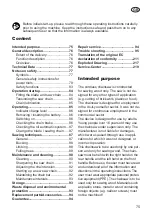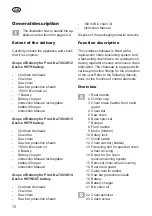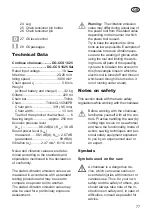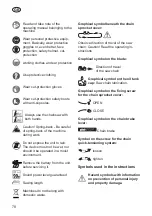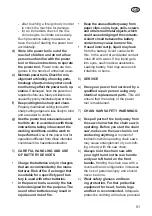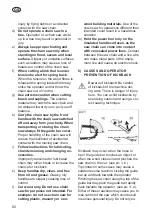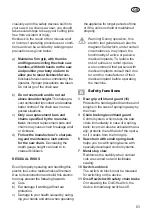
89
GB
• Do not remove support branches until
after the sawing off.
• Branches under tension must be
sawed from below to above, in order to
prevent jamming of the chainsaw.
When working on thicker branches, use
the same technique as when you are
sawing up a felled trunk.
• Work to the left of the log and as near
as possible to the electric chainsaw.
As far as possible, the weight of the
saw should rest on the log.
• Change position to saw off branches
on the other side of the trunk.
• Branches sticking out are cut off sepa
-
rately.(see ).
Felling trees
A lot of experience is neces-
sary in felling trees. Cut down
trees only when you can safely
handle the electric chainsaw. In
no case should you use the elec-
tric chainsaw if you feel unsure
about anything.
• Ensure that no people or animals
are in the field of action. The safety
distance between the tree to be felled
and the nearest-located workplace
must be 2 ½ tree lengths.
• Note the felling direction:
The user must be able to move safely
near the felled tree, to saw off the tree
easily and remove branches.It is to
be avoided that the felled tree snags
itself on another tree. Note the natural
felling direction, which is dependent
on the slope and curvature character-
istic of the tree, wind direction and the
number of branches.
• In the case of sloping ground, stand
above the tree to be felled.
• Small trees, with a diameter of 15-18 cm,
can usually be sawn off with one cut.
• In case of trees with a larger diameter,
a notched cut and a back cut must be
implemented (see diagram).
• If cutting and felling is being carried
out by two or more persons simultane-
ously, the distance between the felling
and cutting persons must be at least
twice the height of the tree to be fellled.
When felling trees, ensure that no other
persons are subject to hazards and
that no material damage is caused. If
a tree should come into contact with a
power line, the supply company must
be informed immediately.
• Dirt, stones, loose bark, nails, clips and
wires must be removed from the tree.
Do not fell any trees when a
strong or changing wind is blow-
ing, if the danger of property
damage exists or if the tree could
fall on electric wires.
Immediately after termination of
the sawing procedure, remove the
ear protection so that you can hear
hooter and alarm signals.
1.
Removal of branches
:
Remove hanging branches by
positioning the cut from above the
branch. With removal of branches,
never work higher than shoulder
level.
2.
Escape area:
Remove the undergrowth around
the tree to ensure an easy
escape. The escape area (1)
should be around 45° either side
behind the planned felling direc-
tion (2).
3.
Cutting notch (A):
Make a felling notch in the direc-
tion in which you wish the tree to
fall. Start with the bottom, hori-

